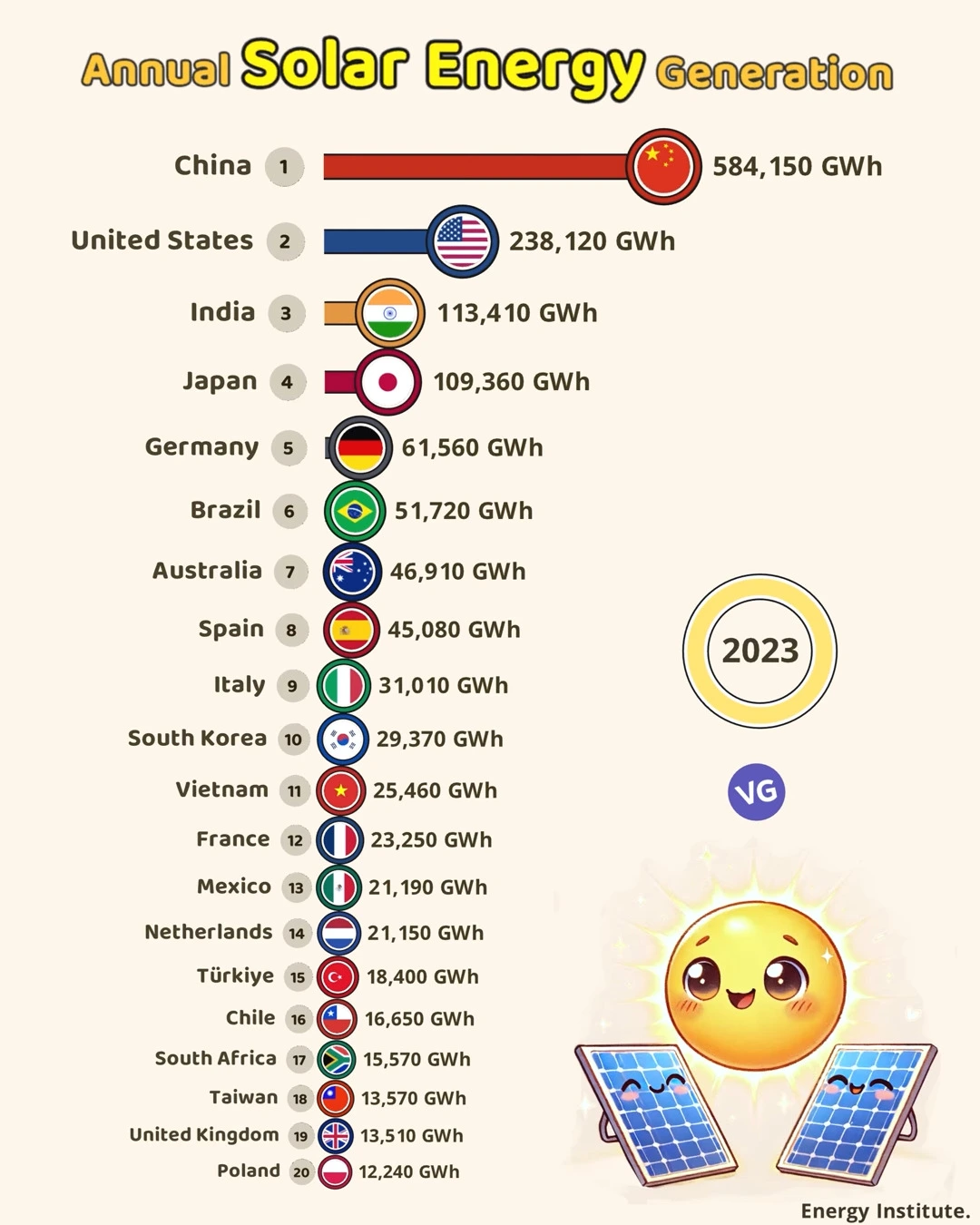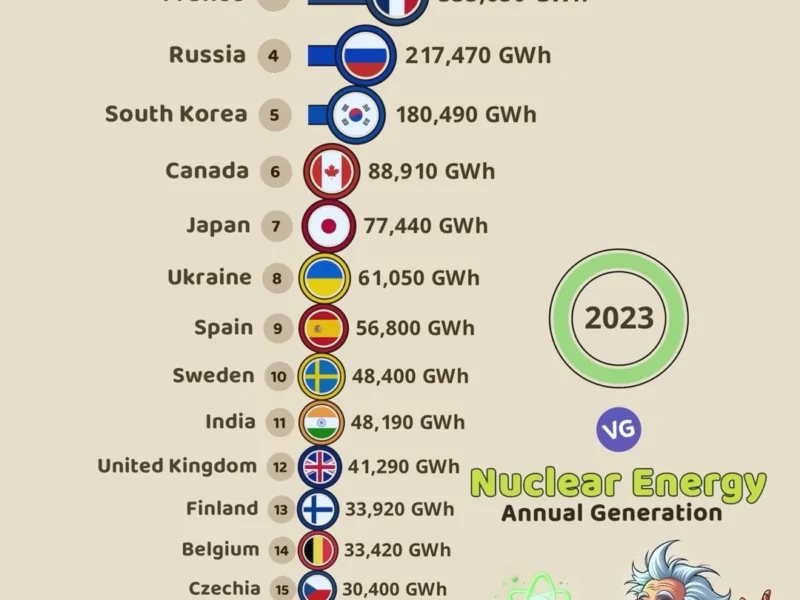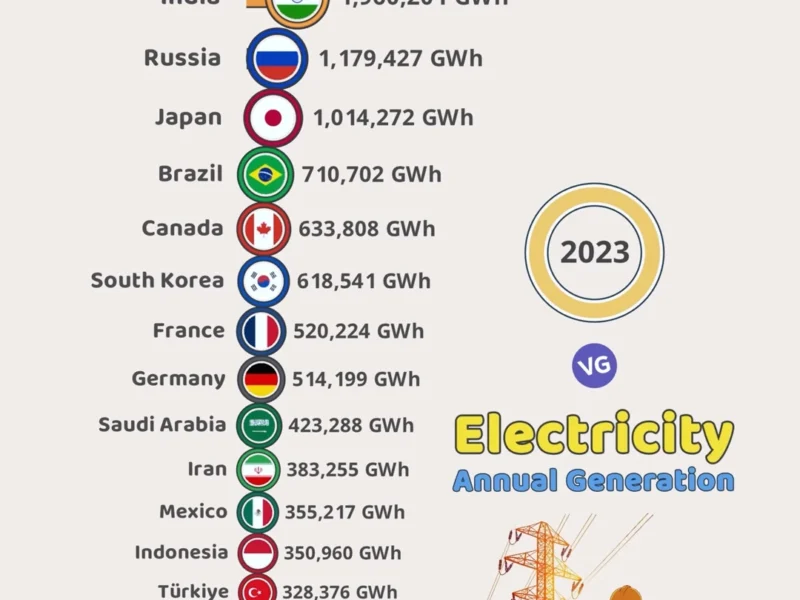Global Solar Energy Generation: Leading Countries in 2023
Solar energy has become a cornerstone of renewable power, with countries around the world investing heavily in photovoltaic (PV) infrastructure. According to the Energy Institute, the largest producers of solar energy in 2023 were led by China, the United States, and India. The growing emphasis on sustainable energy solutions has propelled nations to expand their solar capabilities, reducing dependence on fossil fuels.
Top Solar Energy Producers in 2023
| Rank | Country | Generation (GWh) |
|---|---|---|
| 1 | 🇨🇳 China | 584,150 |
| 2 | 🇺🇸 United States | 238,120 |
| 3 | 🇮🇳 India | 113,410 |
| 4 | 🇯🇵 Japan | 109,360 |
| 5 | 🇩🇪 Germany | 61,560 |
| 6 | 🇧🇷 Brazil | 51,720 |
| 7 | 🇦🇺 Australia | 46,910 |
| 8 | 🇪🇸 Spain | 45,080 |
| 9 | 🇮🇹 Italy | 31,010 |
| 10 | 🇰🇷 South Korea | 29,370 |
| 11 | 🇻🇳 Vietnam | 25,460 |
| 12 | 🇫🇷 France | 23,250 |
| 13 | 🇲🇽 Mexico | 21,190 |
| 14 | 🇳🇱 Netherlands | 21,150 |
| 15 | 🇹🇷 Türkiye | 18,400 |
| 16 | 🇨🇱 Chile | 16,650 |
| 17 | 🇿🇦 South Africa | 15,570 |
| 18 | 🇹🇼 Taiwan | 13,570 |
| 19 | 🇬🇧 United Kingdom | 13,510 |
| 20 | 🇵🇱 Poland | 12,240 |
- China – 584,150 GWh
China remains the undisputed leader in solar energy generation, producing more than double the amount of its closest competitor. The country has invested in massive solar farms, such as the Tengger Desert Solar Park, contributing to its dominance. - United States – 238,120 GWh
The United States ranks second, with extensive solar farms across states like California, Texas, and Arizona. The continued expansion of utility-scale solar projects is expected to increase its production in the coming years. - India – 113,410 GWh
With abundant sunlight, India has rapidly increased its solar energy capacity, particularly in states like Rajasthan and Gujarat. The government’s ambitious renewable energy targets have fueled this growth. - Japan – 109,360 GWh
Japan’s focus on clean energy after the Fukushima disaster has led to significant investments in solar power. The country’s limited land area has resulted in innovative solutions like floating solar farms. - Germany – 61,560 GWh
Despite having less sunlight compared to other nations, Germany remains a leader in solar energy generation due to strong government policies and incentives for renewable energy adoption. - Brazil – 51,720 GWh
Brazil has emerged as a major solar energy producer, driven by an increasing demand for clean electricity and favorable government policies promoting photovoltaic expansion. - Australia – 46,910 GWh
With vast open spaces and high solar potential, Australia continues to expand its solar infrastructure, particularly through large-scale solar farms and rooftop installations. - Spain – 45,080 GWh
Spain has a long history of solar power usage, benefiting from high solar radiation levels and government policies supporting renewables. - Italy – 31,010 GWh
Italy has integrated solar power extensively into its energy grid, taking advantage of its Mediterranean climate. - South Korea – 29,370 GWh
South Korea is investing heavily in solar energy, with plans to increase its renewable capacity to meet sustainability goals.
Expanding Solar Capacity Worldwide
Beyond the top ten producers, countries like Vietnam (25,460 GWh), France (23,250 GWh), and Mexico (21,190 GWh) are making strides in solar power development. The Netherlands (21,150 GWh) leads in solar panel installations per capita, while Türkiye (18,400 GWh) and South Africa (15,570 GWh) continue expanding their renewable energy sectors.
With advancements in solar panel efficiency and decreasing costs, solar energy generation is expected to grow rapidly worldwide. Nations are shifting toward greener alternatives to combat climate change and secure energy independence.
📌 Sources:
- Energy Institute (2023 Report)
- International Renewable Energy Agency (IRENA)
- World Bank Energy Data



